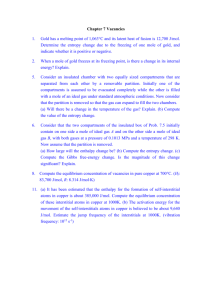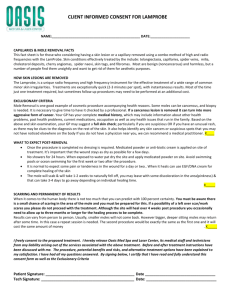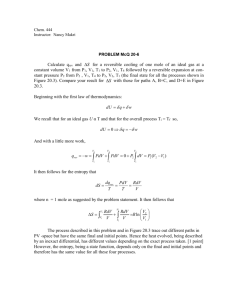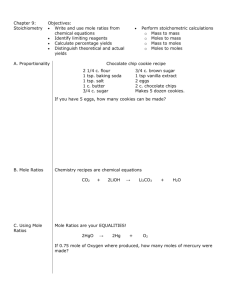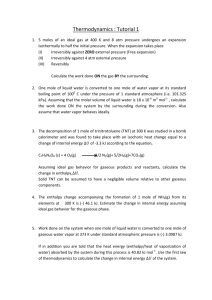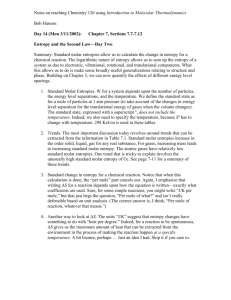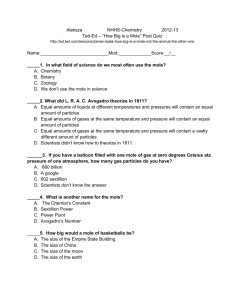SHEET (4)
advertisement
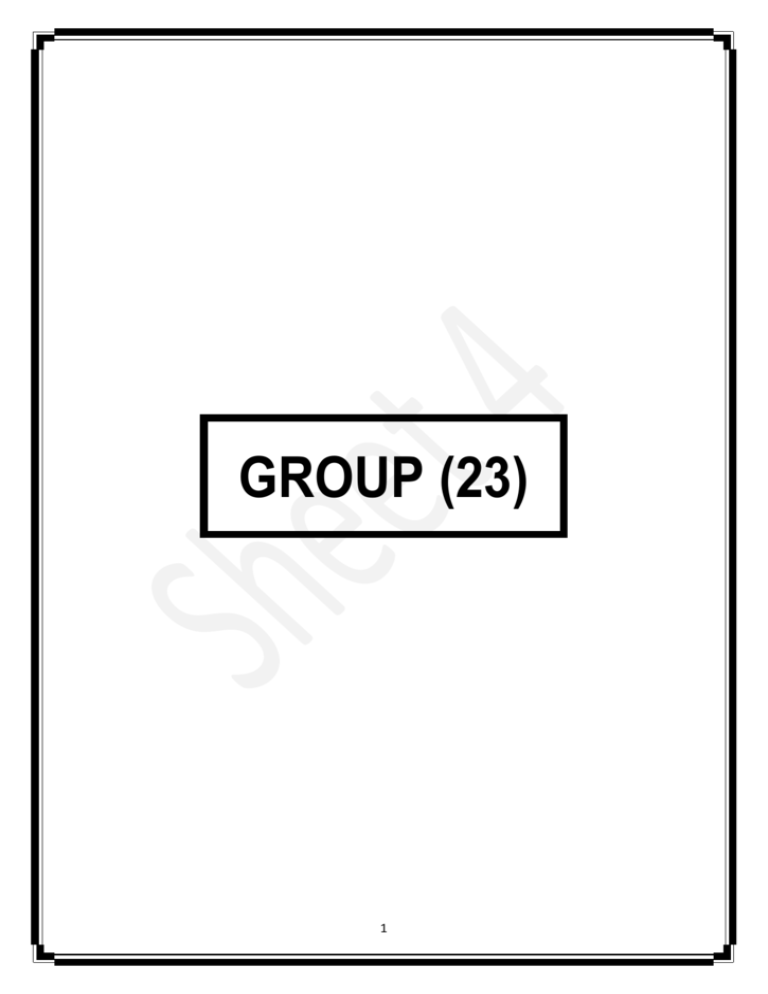
GROUP (23)
1
SHEET (4)
THE STATISTICAL
INTERPRETION OF
ENTROPY
2
Question No. (1)
A rigid container is divided into two compartments of
equal volume by a partition. One compartment contains
1 mole of ideal gas A at 1 atm, and the other
compartment contains 1 mole of ideal gas B at
1 atm.
Calculate the entropy increase in the container if the
partition between the two compartments is removed. If
the first compartment has contained 2 moles of ideal gas
A, what would have been the entropy increase due to
gas mixing when the partition was removed? Calculate
the corresponding entropy changes in each of the above
two situations if both compartments had contained ideal
gas A..
The Answer of Question No. (1)
Case (1): 1 mole ( A ) + 1 mole ( B )
Ω1 =
𝟐 !
𝟐!∗𝟎!
=1
3
Ω2 =
Ω3 =
𝟐!
𝟎!∗𝟐!
𝟐!
𝟏!∗𝟏!
=1
=2
ΩT = Ω1 + Ω2 + Ω3 = 2 + 1 + 1 = 4
S = R 𝐥𝐧 Ω = R ln (4)
Case (2) : 2 mole ( A ) + 1 mole ( B )
Ω1 =
Ω2 =
Ω3 =
Ω4 =
𝟑!
𝟎!∗𝟑!
𝟑!
𝟑!∗𝟎!
𝟑!
𝟐!∗𝟏!
𝟑!
𝟏!∗𝟐!
=1
=1
=3
=3
ΩT = Ω1 + Ω2 + Ω3 + Ω4 = 1 + 1 + 3 + 3 = 8
S = R 𝐥𝐧 Ω = R ln(8)
Case 3 :
1 mole ( A ) + 1 mole ( A )
4
S=0
Question No. (2)
If a silver –gold alloy is a random mixture of gold and
silver atoms, calculate the entropy increase when 10
grams of gold are mixed with 20 grams of silver to
form an ideal homogenous alloy. The atomic weights
of Au and Ag are 197 and 108, respectively.
The Answer of Question No. (2)
NAu =
NAg =
𝟏𝟎
𝟏𝟗𝟕
𝟐𝟎
𝟏𝟎𝟖
= 0.0508 moles
= 0.1854 moles .
NT = NAu + NAg = 0.0508 + 0.1825 = 0.2362 moles .
Ω = n! /( n1! * n2 ! ) =
𝟎.𝟐𝟑𝟔𝟐!
𝟎.𝟎𝟓𝟎𝟖!∗𝟎.𝟏𝟖𝟐𝟓!
= undefined .
∵ 𝐥𝐧 Ω = ( n 𝐥𝐧 𝒏 – n ) – ∑( 𝒏𝒊 𝐥𝐧 𝒏𝒊 − 𝒏i )
= ( 0.2362 𝐥𝐧 𝟎. 𝟐𝟑𝟔𝟐 – 0.2362 ) – (0.1854
𝐥𝐧 𝟎. 𝟏𝟖𝟓𝟒 – 0.1854 )
∴ 𝐥𝐧 Ω = 0.13016
∴ Ω = 1.139
5
∴ S = R 𝐥𝐧 Ω = 1.987 * 0.13016
6
S = .2644
Question No. (3)
Show that for one component very large particles
homogenous system:
U = KT ln (Ω) + nKT ln (P)
Where P is the partition function of the system.
The Answer of Question No. (3)
Ω=
𝐧!
∏𝐧𝐢=𝟏 𝐧𝐢!
ln(Ω𝒏) = ln(𝐧!) – ln(∏𝐧𝐢=𝟏 𝐧𝐢!)
According to stirling law : ln(𝐧!) = nln(n) – n
ln (Ω𝒏)
𝐝𝐋𝐧(Ω𝒏)
𝐝𝐧
= n ln(n) – n – ∑𝒊=𝒓
𝒊=𝒐 𝒏𝒊 𝐥𝐧(𝒏𝒊) − 𝒏𝒊
= d(n) . ln(n) +dln(n) . d(n) . n
− { ∑𝒊=𝒓
𝒊=𝒐 𝒅(𝒏𝒊) 𝐥𝐧(𝒏𝒊) + 𝒅𝒍𝒏(𝒏𝒊)𝒅(𝒏𝒊)𝒏𝒊 −
𝒅(𝒏𝒊)}
7
𝐝𝐋𝐧(𝐧Ω)
𝐝𝐧
= _ ∑𝒊=𝒓
𝒊=𝒐 𝒅(𝒏𝒊) 𝐥𝐧(𝒏𝒊) = 0
(1)
= ∑𝒊=𝒓
𝒊=𝒐 𝒏𝒊 𝑬𝒊
∵U
= ∑𝒊=𝒓
𝒊=𝒐 𝒅(𝒏𝒊)𝑬𝒊 = 𝟎
dU
(2)
∵ n = ∑𝒊=𝒓
𝒊=𝒐 𝒏𝒊
Since (n) is constant , thus :
dn = ∑𝒊=𝒓
𝒊=𝒐 𝒅(𝒏𝒊) = 𝟎
(3)
By multiplication equation (2) in constant (β) and
equation (3) by constant (α) then sum equations
(1) , (2) and (3) .
𝒊=𝒓
∑ 𝒍𝒏(𝒏𝒊). 𝒅(𝒏𝒊) + 𝛂. 𝐝(𝐧𝐢) + 𝛃. 𝒅(𝒏𝒊) = 𝟎
𝒊=𝟎
ln(ni) + α + β Ei =0
ln(ni) = - α - β Ei
ni = 𝒆− 𝜶− 𝜷 𝑬𝒊
−𝛂 ∑𝒏
− 𝛃 𝐄𝐢
n = ∑𝒊=𝒓
𝒊=𝟎 𝒏𝒊 = 𝒆
𝒊=𝟎 𝒆
𝒆
−𝛂
=
𝒏
− 𝛃 𝐄𝐢
∑𝒏
𝒊=𝟎 𝒆
We found β α
𝟏
𝑻
= 𝒏⁄𝒑 ,
or β =
𝟏
𝒌𝒕
8
ni =
− 𝛃 𝐄𝐢
𝒏 ∑𝒏
𝒊=𝟎 𝒆
𝒑
𝑹
where k is boltzman constant k =
𝑵 𝑨𝑽𝑶𝑮𝑨𝑫𝑹𝑶
If the number of particles in the system is very
large then the number of arrangement within most
probable distribution , Ω𝒎𝒂𝒙,is the only term which
makes a significant contribution to the total number
of arrangement , Ω𝒕𝒐𝒕𝒂𝒍, which the system may
have that is Ω𝒎𝒂𝒙 is significantly larger than the
sum of all other arrangement
, hence :
Ω𝒎𝒂𝒙 = Ω𝒕𝒐𝒕𝒂𝒍
ln (Ω𝒎𝒂𝒙) = ln (Ω𝒕𝒐𝒕𝒂𝒍)
𝒏
= n ln(n) – n – ∑𝒊=𝒓
𝒊=𝒐 𝒏𝒊 𝐥𝐧(𝒏𝒊) − ∑𝒊=𝟎 𝒏𝒊
= n ln(n) – ∑𝒊=𝒓
𝒊=𝒐 𝒏𝒊 𝐥𝐧(𝒏𝒊)
Hint : ni =
− 𝐄𝐢/𝐊𝐓
𝒏 ∑𝒏
𝒊=𝟎 𝒆
𝒑
= n ln(n) –
= n ln(n) –
= n ln(n) –
𝒏
𝒑
− 𝐄𝐢/𝐊𝐓
𝒏 .𝒆
∑𝒊=𝒓
𝒊=𝒐
𝒑
𝒏
∑𝒊=𝒓
𝒑 𝒊=𝒐
𝒆
− 𝐄𝐢/𝐊𝐓
𝐥𝐧 (
𝒏 . 𝒆− 𝐄𝐢/𝐊𝐓
𝐥𝐧 (
𝒑
𝒏 .𝒆− 𝐄𝐢/𝐊𝐓
𝒑
− 𝐄𝐢/𝐊𝐓
∑𝒊=𝒓
{𝒍𝒏(𝒏) − (
𝒊=𝒐 𝒆
𝑬𝒊
)−
𝑲𝑻
𝒍𝒏(𝒑)}
9
)
)
𝒏
= n ln(n)–
𝒏
𝑷𝑲𝑻
. ∑𝒏𝒊=𝟎 𝒆− 𝐄𝐢/𝐊𝐓 . {ln(n)-ln(p)}+
𝒑
− 𝐄𝐢/𝐊𝐓
∑𝒏𝒊=𝟎 𝒆
Hint : ∑𝒏𝒊=𝟎 𝒆− 𝛃 𝐄𝐢 = p
= n ln(n) - n ln(n) + n ln(p) +
= n ln(p) +
= n ln(p) +
𝒏
𝑷𝑲𝑻
𝒏
𝒑𝑲𝑻
FROM U =
U=
𝑼. 𝑷
𝑵
𝒑
𝒑
∑𝒏𝒊=𝟎 𝒆− 𝐄𝐢/𝐊𝐓
∑𝒏𝒊=𝟎 𝒆− 𝐄𝐢/𝐊𝐓
∑𝒏𝒊=𝟎 𝒆− 𝐄𝐢/𝐤𝐭
∑𝒏𝒊=𝟎 𝒏𝒊
𝒏
𝒏𝛃
𝑬𝒊 and
(4)
ni =
− 𝐄𝐢/𝐤𝐭
𝒏 ∑𝒏
𝒊=𝟎 𝒆
𝒑
∑𝒏𝒊=𝟎 (𝑬𝒊) 𝒆− 𝐄𝐢/𝐤𝐭
=∑𝒏𝒊=𝟎 (𝑬𝒊) 𝒆− 𝐄𝐢/𝐤𝐭
10
(5)
FROM (5) IN (4) :
Ln(Ω) = n ln(p) +
Ln(Ω) = n ln(p) +
𝐍
𝐔. 𝐏
𝐏𝐊𝐓
𝐍
𝐔
𝐊𝐓
U = KT ln(Ω)+ nKT ln(P)
11



